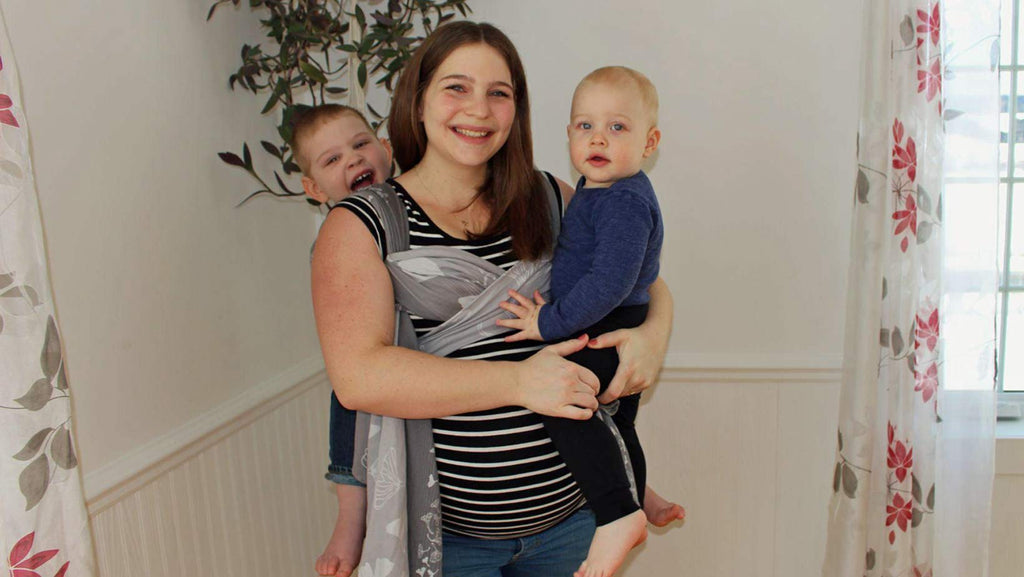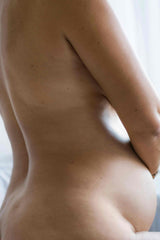
‘‘I’m pregnant, can I still carry my older kid?’’ is a question many women ask themselves, as they wish to keep on babywearing and maintaining their precious connection with their eldest child. Carrying your first child while pregnant can bring up many questions for moms and we’ll do our best to answer them in this article.
It’s crucial to take into consideration some important elements before attempting the experience. Since the body already needs to adapt itself to major physical changes, even if you’re already used to babywearing, you will probably need to make changes to your carrying habits. Pregnancy often comes with new limitations, and that’s perfectly natural. Besides, for those who have never tried babywearing, pregnancy might not be the ideal time to get started. If you still wish to get introduced to the technique, do it with someone who has experience who will guide you toward a safe and physiological babywearing technique.
Obviously, the priority remains on having a healthy pregnancy. Before choosing babywearing, it’s highly recommended, nay imperative, to consult the health professional in charge of monitoring your pregnancy to make sure that everything is in order.
Even if your doctor or midwife has given you their approbation, remain on the lookout for signs your body might be sending you. It is your best ally to inform you that it’s time to take a break or to stop babywearing altogether.
What are these signs?

Back and lumbar pain
These types of pains generally manifest themselves frequently during pregnancy. They can be caused by multiple factors, like postural changes, for example. Babywearing a toddler could intensify your discomfort and if so, it would be important to understand their causes so as to either carry the pregnancy to term without babywearing, changing carrying positions or use a more suitable baby carrier.
Contractions
Obviously, if you’re experiencing contractions each time you carry, the message is clear: you need to stop immediately. It should be noted that if you only experience contractions at the end of the day, this could be a sign of fatigue or of having made an excessive physical effort. In this case, you shouldn’t ignore the warning, even if they’re just Braxton-Hicks contractions (also called ‘false contractions’).
A sensation of pressure at the pelvic floor
The pelvic floor, also called perineum, is the hammock-shaped group of muscles that’s situated at the base of the pelvis. During pregnancy, these muscles hold up the baby’s weight and, over time, can be weakened by this pressure. Furthermore, when pregnant, the body secretes relaxin, whose goal is to make the muscles and ligaments more pliable. Because of this, the perineum is more relaxed than per usual. All of this put together will sometimes provoke discomfort, and eventually create different problems like stress incontinence and back or pelvic pain. You can understand how adding the extra weight of carrying your child could worsen the situation and bring on short and long-term consequences. Also, if you feel pelvic floor discomfort, experience bladder leaks or other symptoms, know that a physiotherapist specialized in pelvic and perineal reeducation is the best person to help you.
Excessive fatigue
This happens more often to women who are in great shape and have the habit of being very active in their day-to-day. They feel the need to get moving and can have a hard time taking into account their new, albeit temporary, physical limitations. Slowing their rhythm down can cause them stress and listening to their own body becomes a daunting challenge. If you recognize yourself in this description, stay vigilant and impose yourself some regular downtime to make sure that you won’t have to give it all up during your pregnancy due to extreme fatigue.
In short, your body speaks to you so that you can take care of it and of your baby, and with all your heart.
Now, which baby carrier should you choose?
A woven baby wrap worn in a back carry, using a tie like the Kangaroo carry, without going over the hips to finish, is an interesting solution. A tie and carry of this type will reduce the pressure applied to your pelvis and belly.
A ring sling, when worn on the hips, can be an option for short carrying sessions. Quick and easy to use, it applies no pressure on the belly.
A structured baby carrier like our Bambino, our TREK 2.0, or our Mei Tai, with its belt placed under the belly, when possible, could help with redistributing the weight and minimize the pressure applied to the back.
Before we finish, a word on the center of gravity.
With the increasing weight of the uterus, your center of gravity will naturally start to migrate forward and this phenomenon brings an increased risk of losing your balance and falling. By adding the weight of carrying your child, these risks can rise further. We’d like you to be careful when being physically active while babywearing and when using the stairs.
In conclusion, babywearing during pregnancy can be done safely. However, it’s essential to prioritize your health and pregnancy, to consult with your health professional, and to pay attention to potential signs that you need to take a break. By choosing babywearing techniques adapted to your condition and using specific baby carriers, future moms can enjoy the benefits of babywearing while ensuring their safety and their baby’s.






Share:
5 Tips to Ease Your Newborn Into a Safe and Peaceful Sleep
5 Aspects to Consider to Protect Your Baby From Illnesses and Viruses in Winter